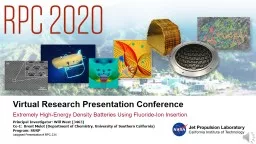

Extremely HighEnergy Density Batteries Using FluorideIon Insertion Assigned Presentation RPC234 Principal Investigator Will West 3463 CoI Brent Melot Department of Chemistry University of Southern California Program ID: 933200
Download Presentation The PPT/PDF document "Virtual Research Presentation Conference" is the property of its rightful owner. Permission is granted to download and print the materials on this web site for personal, non-commercial use only, and to display it on your personal computer provided you do not modify the materials and that you retain all copyright notices contained in the materials. By downloading content from our website, you accept the terms of this agreement.
Slide1
Virtual Research Presentation Conference
Extremely High-Energy Density Batteries Using Fluoride-Ion Insertion
Assigned Presentation # RPC-234
Principal Investigator: Will West (3463)
Co-I: Brent Melot (Department of Chemistry, University of Southern California) Program: SURP
Slide2Abstract
A relatively new cell chemistry, the fluoride ion battery, presents a promising battery cell design that offers the potential to significantly exceed the energy density of state-of-practice Li-ion batteries.The objective of the SURP effort was to demonstrate and develop a new, high energy density battery technology based on fluoride-ion insertion. The SURP effort builds on prior foundational discovery at JPL and Caltech identifying for the first time a liquid fluoride-ion electrolyte. New electrode materials coupled with the new electrolyte were to be studied in this work.We identified several classes of materials that could reversibly insert and de-insert fluoride ions, demonstrating functional cells working on this new principle. We have filed an NTR and a Caltech provisional patent based on this work. Carry on funding will be sought through NASA and DOE.Tutorial IntroductionStrontium iron oxyfluorides are very promising fluoride insertion hosts for novel fluoride-ion batteries. a) SrFeO2F, b) Sr2FeO3F , c) Sr3Fe2O5F2.
Slide3Context: After several decades of intensive research and commercialization, the energy density of state-of-art Li-ion cell may be approaching an asymptotic limit. The novel fluoride-ion battery presents an entirely new battery cell design that offers the potential to significantly exceed the energy density of state-of-practice Li-ion batteries.
SOA: Li-ion batteries ≈ 700 Wh/l; first generation FIB have the potential to exceed 900 Wh/l with significant improvements over time in analogy to Li-ion battery advancementsProblem DescriptionLi-ion battery energy density may be approaching the limits on energy density. Future leaps in performance may come with alternate cathode and anode materials. https://cleantechnica.com/files/2020/02/bloomberg-nef-battery-lithium-ion-cell-energy-density-chart-graph-BNEF.png
Relevance: Development of this FIB technology will enable longer run times and greater capabilities for on-board instrumentation, which is key to the success of future missions. In addition, this technology has very significant infusion potential into many terrestrial applications (e.g., transportation, portable devices).
Sr
xFeOyFzAnode(USC)
Np1:BTFEElectrolyte (JPL/ Caltech)
a-Carbon Cathode
(JPL)
F-ion batteries may exceed state-of-art Li-ion batteries in both energy density and specific energy.
Slide4Consider perovskite and
Ruddlesden-Popper families of materials from the class of strontium iron oxyfluorides as intercalation hostsIntrinsic fluoride ion channels and synthetic tenabilityAlso consider BiF3 as a classic conversion compoundServes as a used to benchmark electrolyte stability over extended cyclingPrepare Sr-Fe-O-F compounds by two different methods at USC: Allows control the degree of fluorination for sample tuningSr2FeO3F prepared traditional solid-state ceramic methods, with SrF2 as the F source Sr3Fe2O5F2 prepared by synthesizing Sr3Fe2O
7 using solid-state ceramic methods and was post-synthetically fluorinated via PVDF decomposition at 300 ℃Perform a suite of electrochemical and structural measurements on synthesized F-(de)intercalation compounds XRD, CV, EIS, charge/discharge cyclingCarry out conversion electrode studies of against high-surface area amorphous carbon counter electrodes at JPLIncludes ex-situ XRD of charged and discharged BiF3 electrode to confirm electrochemical reaction mechanisms.MethodologyX-Ray diffractograms of various strontium iron oxyfluorides prepared in this study.
Cyclic voltammogram of Sr
2FeO3F
Slide5Results
Next steps:
Complete electrochemical characterization of strontium iron oxyfluorides in full cell configurationCarry out operando XRD to directly observe (de) intercalation processPublish finding and seek DOE/NASA carry out funding
Key Accomplishments
Developed two synthetic techniques for preparing phase-pure novel F-ion hosts
Demonstrated reversible intercalation of multiple fluoride ions per unit cell in novel oxyfluoride compounds
Identified a high-performance counter electrode capable of relatively high Coulombic efficiency
Significance
A viable F-ion cell has been demonstrated with Caltech/JPL’s liquid electrolyte, USC intercalation electrode, and JPL’s amorphous carbon electrode.
The accomplishment sets the stage for further elaboration of the design with higher capacity and higher voltage electrodes
Slide6“Fluoride Ion Capacitor”, William C. West, Stephen A. Munoz, New Technology Report #51526, (2020).
“Fluoride Ion Capacitor”, William C. West, Stephen A. Munoz, Provisional Patent Application, CIT File No. CIT-8454-P, (2020).Publications